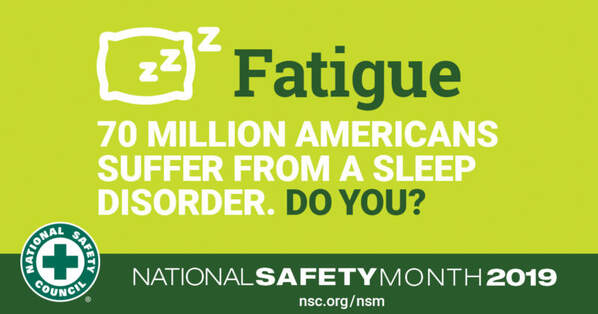|
How many times have we all not done something the way it should be done simply because we are too tired? Or cut corners to shave a little bit of time off a project because it’s been so intense to work on? How many near misses with errors or injuries have we all had because we are unable to focus or have turtle speed reaction times?
Employee fatigue can be expensive, decrease your companies’ productivity and ultimately your bottom line. Employers and employees are becoming increasingly aware that workplace fatigue can be a serious safety issue. Let’s dig into workplace fatigue a bit and see what we all can do to help combat this surprisingly common and often overlooked safety concern. What is fatigue? The dictionary defines fatigue as “extreme tiredness resulting from mental or physical exertion or illness”. Fatigue can be caused by a number of things, both work and personal. Physical stresses such as lifting heavy objects or operating machinery or tools for long periods of time can cause physical fatigue. Mental stresses such as prolonged periods of intense focus or long, difficult or spirited meetings can cause mental fatigue. Other factors such as long commutes, working overnight shifts, not having adequate rest during or after shifts, long hours, work environment conditions like dim lighting or noisy conditions, longer hours, can all play a role in workplace fatigue. Even having poor social interactions with your co-workers can cause fatigue. It’s not just about how much or how good of sleep you get. Effects of fatigue Fatigued people lack focus and fall behind on projects or simply don’t have the energy to pay attention to what is going on around them. Slower reaction times and decreased cognitive ability can have devastating safety consequences. Simply put – when people are fatigued they tend to make bad choices. In this article from the National Safety Council (NSC), Fatigue – You’re More Than Just Tired, there are some eye-opening facts on fatigue and what it does to our bodies, our productivity, our mental health, and overall wellness. Fatigued workers are also more apt to contract common illnesses and struggle with overcoming them. Since people suffering from fatigue are already experiencing physical effects from fatigue they are more susceptible to common illnesses and can’t fight them off as easily. That, in turn, leads to more sick days, less production time, and yep, more stress. It can be a vicious cycle. Who does fatigue affect? While fatigue affects everyone, night shift workers, drivers, healthcare, and construction workers are most a risk. According to this article published by OSHA our bodies operate on a circadian rhythm sleep/wake cycle. It is naturally programmed for sleeping during night hours. Demanding work schedules may disrupt the body’s natural cycle, leading to increased fatigue, stress and lack of concentration. Long work hours and extended and irregular shifts may lead to fatigue and to physical and mental stress. How does fatigue harm the workplace? Some of the most deadly catastrophes in the past 30 years have been caused in part by fatigue due to sleep deprivation. According to this article citing Dr. Denis Cronson; in the Exxon Valdez oil spill, employees had been working up to 14-hour shifts and a tired third mate had fallen asleep at the wheel, causing the second largest oil spill in American history. In the Chernobyl disaster, the power plant exploded after engineers had worked 13 hours or more, causing probably the worst nuclear disaster in history. In the Canadian National train disaster, two crewmen on one of the freight trains suffered from sleep apnoea that caused chronic sleeplessness and resultant fatigue and crashed into another train, spilling 3000 gallons of diesel and finally in the Air France disaster, the official report concluded that the pilot had had only had one hour of sleep the night before, and was taking a nap when the plane collided with a tropical storm, killing all 228 people on board. OK so those are extreme examples but they put into perspective what can happen with fatigued workers. And what can happen if employers don’t recognize and address fatigue in their employees? Here are some examples from Safety News Alert of how fatigue can harm our workplaces:
SO……what the heck do we do about it? Now that are you sufficiently bombarded with doom and gloom facts….let’s talk about how we can recognize, deal with, and help prevent fatigue in our workplace. We understand that you can’t control your employees once they are off the clock. You can’t tuck them into bed every night, but there are things you can do to help them understand how to deal with fatigue and how to let you know when they are getting to their breaking point.
We hope that we have given you some helpful information and actions that you can take to increase awareness of fatigue at your facility and with your employees and co-workers. As always, please Contact Us, if you have any questions about our products or services. We are here to help in any way that we can. Comments are closed.
|
AuthorVarious. Categories
All
Archives
August 2023
|
- Home
- About
- Career Opportunities
- Services
-
Equipment
- Dock Locks (Truck Restraints) >
- Fans & In-Plant Equipment >
-
Industrial / Commercial Doors
>
- High Speed Fabric Doors
- Security High Speed
- Rubber Doors
- Fire Door
- Rolling Steel
- Impactable Dock Doors
- Cooler / Freezer
- Fabric Roll-Up
- Impact / Traffic / Bump
- Overhead / Sectional Doors
- Operators / Activation
- Air Curtains / Screen & Bug Doors
- Strip Doors
- Door Entrapment Protection
- Door Protection
- Overhead Door Upgrades
- Loading Dock Levelers & Lifts >
- Loading Dock Seals & Shelters >
- OEM & Aftermarket Parts
- Safety / Energy / Security / Employee Comfort >
- Yeti Snow Removal
- Markets
- Blog
- Contact
Dock & Door Tec
Serving Minnesota, Wisconsin, Iowa, North Dakota & South Dakota
Serving Minnesota, Wisconsin, Iowa, North Dakota & South Dakota


 RSS Feed
RSS Feed
